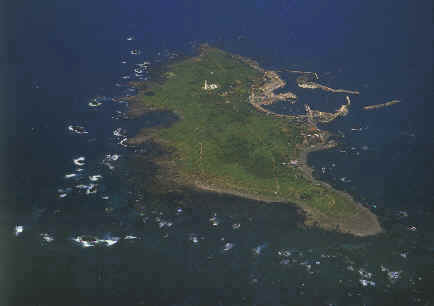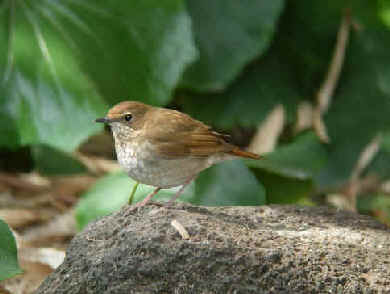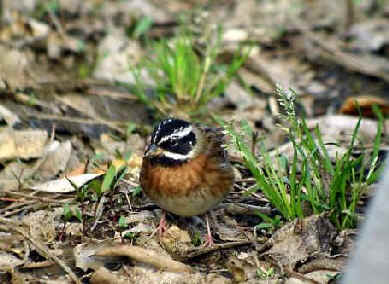
E-mail: font@focusonnature.com
Phone: Toll-free in USA 1-800-721-9986
or 302/529-1876; Fax: 302/529-1085
 |
PO Box 9021,
Wilmington, DE 19809, USA E-mail: font@focusonnature.com Phone: Toll-free in USA 1-800-721-9986 or 302/529-1876; Fax: 302/529-1085 |
THE
FONT BIRDING & NATURE TOUR IN JAPAN
May 2006

Little
Hegura
Island, off the west coast of Japan,
is a tremendous and exciting place for bird migration in the spring.
Links:
List
of Birds & Other Wildlife during our Japan Spring Tour - May '06
Cumulative List of Birds during our Japan Spring Birding Tours
Upcoming FONT Birding & Tours in Japan
home
The following account written by Armas Hill, leader
of the tour:
During the May
2006 FONT birding & nature tour in Japan
(our 26th tour there; our 10th in the spring), there were thousands of Streaked
Shearwaters seen from the ferry (an hour-and-a-half ride) to Hegura
Island in the Sea of Japan. Also
in flocks, were hundreds, as many as a thousand, Red-necked Phalaropes.
The water of the sea was smooth. And, as it was like glass, the alcids
sitting on the water were relatively easy to spot. Most were Rhinoceros
Auklets. There were also Japanese Murrelets, which are endemic to
Japan, endangered, and attractive black-and-white birds with a nice Japanese
name, "Kanmuri-umisuzume", It's pronounced as it looks.
The alcids breed on rocky islets by which the ferry closely passes. On
the slopes of those small islands, thousands of Black-tailed Gulls were
at their nesting sites. Many were seen flying close to the boat.
During the return ferry-ride from the island a couple days later, Streaked
Shearwaters still abounded. The sea was not as calm, and there was more of a
breeze. So more shearwaters were seen in flight, probably as many as 20,000.
During the earlier trip to the island, with different conditions, an estimated
10,000 were seen. It was fun to watch so many shearwaters, in flocks lifting
from the water and flying about. The species is actually incredibly abundant
over oceanic waters around Japan, where the total population is said to be
between 2.5 and 5 million.
As noted, our ferry-ride was to and from a place called Hegura
Island (or Hegura-jima).
That little island is one of the foremost places anywhere in the world to
experience bird migration. For its size, it may well be the best piece of land
on Earth for such migration, during the spring (and it's also good later in
the year, in the late-summer and fall, although FONT has yet to be there then). Such
statements are not exaggerations. As many as approximately 360 species of birds
have been recorded on Hegura Island. And at least a new species is added every
year.
Hegura Island is in the Sea of Japan, off the west coast of Honshu (the main
Japanese island). And yes, it is small - only 1 kilometer wide and less than
2 kilometers long. One can easily walk the path around the entire coastline of
the island in less than an hour.
Some people live on the island. But not many, about 150. There was a small store
(no longer), an inn (where fortunately we can overnight and have
meals), some homes, a school (just recently closed; there was an
enrollment of 5), and 1 doctor. The most prominent structure on the island
is a tall, white lighthouse. In the morning, the women of Hegura dive offshore
for seaweed. Later in the day, if sunny, they put it out to dry. Men go out on
boats to fish.
People, such as us during our Spring Birding Tour in Japan, go to Hegura to
bird. During our 2006 tour, we were on
Hegura May 10-12. It was our 5th tour to
visit Hegura. 4 of the tours have been in the month of May. Once, we visited in
April. In all, during those 5 tours, we've found a cumulative total of 151
species of birds on Hegura Island. A complete list of those birds is elsewhere
in this website (there's a link above).
During spring migration, landbirds, shorebirds, and waterbirds occur
on Hegura. Many landbirds, especially as they travel at night, on their way
north, come across the small island in the sea. Given optimum conditions, in the
spring, the island can be filled with birds. They're in the open on fields, or
they're in bushes, small trees, under debris by the homes, or along the rocky
coast. In short, they can be everywhere.
Birds that elsewhere can be notorious skulkers are often, on Hegura, more out in
the open. In that category, for example, are the shy Japanese Robin, Siberian
Blue Robin (*), and the White's Ground Thrush (*). (Those with an (*)
were found during our May '06 tour.)
Routine migrants are enroute from where they've wintered in the Asian tropics to
where they'll breed as far north as Siberia. These include: Siberian
Rubythroat (*), Siberian Stonechat (*), and Yellow-breasted
Bunting. (Again, those with an (*) were found during our May '06
tour.)
There are, on Hegura, birds migrating north that are generally more common on
the Asian mainland along the Chinese and Korean coasts than they are in Japan.
There are a number of birds in that category that we've seen during our 5 FONT
tours on the island, including: Chinese Egret (*), Chinese Pond Heron
(*), Purple Heron (*), Hoopoe, Richard's Pipit, White-throated Rock
Thrush, Swinhoe's (or Rufous-tailed) Robin (*), Dusky
Warbler, Mugimaki Flycatcher (*), Tricolored Flycatcher (*), Red-throated
Flycatcher, Black-naped Oriole, Chestnut Bunting, and Tristram's Bunting
(*). (Once again, those species with an (*) were found during our tour in May
'06.)
In all, we saw 84 species of birds on Hegura Island in May 2006.
Among them, in addition to those already referred to above with an (*), we also
saw:
both Temminck's and Pelagic Cormorants,
Japanese Sparrowhawk, Grey-faced Buzzard, Northern Hobby, and Peregrine
Falcon,
Mongolian Plover, Black-tailed Godwit, Red-necked Stint, Green and Common
Sandpipers,
Grey-tailed (or Polynesian) Tattler,
Common and Latham's Snipes,
Black-tailed, Vega (Herring), Slaty-backed, and Glaucous-winged Gulls,
Common, Oriental, and Lesser Cuckoos,
a Jungle (or Grey) Nightjar sitting still
during the day on a fence, and asleep even as it was surrounded by people with
cameras, binoculars, and telescopes (a photo of this bird is now on the
home-page of our website: www.focusonnature.com)
the Dollarbird (a Roller),
Buff-bellied Pipit (the Siberian race) and Yellow Wagtail,
Ashy Minivet,
Red-flanked Bluetail (also called either Siberian Bluechat or
Orange-flanked Bush-Robin)
Siberian Thrush, Japanese Grey Thrush, Eye-browed Thrush, Dusky Thrush,
Japanese Bush Warbler, Oriental Great Reed Warbler, Black-browed Reed Warbler,
Eastern Crowned Warbler, Sikhalin (or Pale-legged) Warbler,
Arctic Warbler,
Blue-and-white Flycatcher (the males are beautiful), Asian Brown
Flycatcher,
Siberian (or Dark-sided) Flycatcher, Grey-streaked
Flycatcher,
Narcissus Flycatcher (this was certainly a favorite bird of our visit -
the attractive males were so common and so tame, sometimes they were in bushes
and trees, but other times they were on sidewalks in front of us, on fences
beside us - just about anywhere!)
Japanese Paradise Flycatcher (what a gem!),
Brown Shrike,
Brambling, Eurasian Siskin, Hawfinch,
Japanese Yellow Bunting, Yellow-throated Bunting, Rustic Bunting.
Among the most interesting aspects relating to the bird migration when we were
at Hegura in May '06 was that there were 3 "special" egrets &
herons among others at one corner of the island. With Little,
Intermediate, and Great Egrets, and some Grey Herons at pools
of water among the rocks by the shore, there were "the 3", 1 of each: Chinese
Egret, Chinese Pond Heron, and Purple Heron. It was like a little
piece of China at that one spot on the island. And all 3 were "new
birds" for us, not just for Hegura, but for Japan.
The Chinese (or Swinhoe's) Egret, that breeds
along the coasts of China and Korea, is one of the rarest egrets in the world.
The population is estimated as being between 1,800 and 2,500 birds. Other
heron-types that are more rare are also in Asia: the White-bellied Heron (of
Bhutan, Bangladesh, and Burma, now Myanmar), the White-eared Night-Heron
(of China), and the Japanese Night-Heron (breeds in Japan,
winters in the Philippines).
The Chinese Egret is similar to the Little Egret of the Old World
and the Snowy Egret of the New. It has a shaggy crest when in breeding
plumage as our bird was, more so than a Snowy, and not with a plume as
had by a Little. We enjoyed a good look at the rare bird.
Our look at the Chinese Pond Heron was nice, simply put, because in its
breeding plumage (as our bird was), it was a nice bird to see. It was an
attractive bird, with its head, neck, and breast a reddish-brown, its back
black, and its belly white.
The Purple Heron is another attractive bird that is in some ways
reminiscent of the Tricolored (formerly Louisiana) Heron
of North America. It, the Purple Heron that is, ranges across Eurasia.
The subspecies on Hegura was Ardea purpurea manilensis, the easternmost
of 3 subspecies, occurring from Siberia to the Philippines, but only as a
vagrant in Japan.

Swinhoe's Robin
Two names of people have been
referred to in this narrative in the names of birds, particularly the Swinhoe's
Robin and Swinhoe's (or Chinese) Egret,
and the Tristram's Bunting. Both of these men, Robert Swinhoe and Henry
Baker Tristram, were British ornithologists and collectors in the 1800s.
Robert Swinhoe collected specimens, that went to the British Museum in London,
from China. Not only were the robin and egret named after him, so
was a storm-petrel in the Far East.
Henry Baker Tristram traveled widely and collected specimens in North Africa and
the Middle East (Palestine), also for the British Museum. He lived for a while
in Bermuda, but during most of his life he lived in England. He collected
specimens during a visit to North America in the vicinity of Niagara Falls. His
collection of bird specimens, from around the world, was huge. In his early
seventies, he printed a catalog listing 17,000 skins in his collection, of about
6,000 species! And during the 10 years of his life after that he accumulated
another 7,000 skins that went to the Academy of Natural Sciences in
Philadelphia! Tristram contributed articles extensively to the ornithological
journal, the Ibis. In addition to the Tristram's Bunting, a bird normally
of mainland Asia and not Japan, mentioned here earlier (and that we saw -
both male & female - on Hegura Island), a storm-petrel of the Far
East was named after him, as one was for Robert Swinhoe.
During May 2006, we saw the Tristram's Bunting on Hegura Island, Japan,
100 years after Henry Baker Tristram died in March 1906.

Tristram's Bunting
When we've visited Hegura Island
during our tours, we've always had the good fortune to share our experiences
with a number of Japanese birders and photographers. Dozens of them have visited
there when we have, also (like us) to see the birds, and of course to photograph
them too. They journey from throughout Japan to encounter the birds on their
journeys. One of the birds during our '06 Hegura tour was a particularly good
and well-known traveler, the Peregrine Falcon. Known for its journeying,
the bird even has a word synonymous with travel named after it,
"peregrination".
One morning on Hegura, a large female Peregrine was sitting on a big rock, by
the sea, along the shore. In front of it, there were about 2 dozen Japanese
photographers and birders with cameras set up and binoculars lifted up. The
Peregrine, resting during its trip probably from the tropics to the tundra, sat
there tamely, aware of, but rather oblivious to, the people. When we left Hegura
on the ferry later that day, the last bird on the island that we saw was that
Peregrine in the distance, perched high atop the communication tower.
During our May '06 tour, nearly 80 (actually 79) species of birds were
seen on the main Japanese island of Honshu.
Some were particularly notable, including:
the Great Knot, a shorebird that breeds only in eastern Siberia,
and winters in Australia and Southeast Asia,
and other shorebirds including Bar-tailed Godwits, Long-billed Plover,
Grey-tailed Tattler at a number of locations (even inland), and a fine flock
of Mongolian Plovers with many in their richly-colored breeding plumage (the
last of these is also called the Lesser Sandplover).
There were some nice birds along streams, including: 3 species of wagtails,
the Greater Pied Kingfisher, and the Brown Dipper.
In the forested hills of interior Honshu, we enjoyed Japanese Grosbeaks,
the Japanese Pygmy Woodpecker, the Siberian Meadow Bunting, the
local race of the Eurasian Jay, and the Varied Tit (along with
other tits, Eurasian Nuthatch, Japanese White-eyes, and other
birds).
On a reservoir, among waterbirds, a bird that was particularly enjoyed
was an adult male Smew, that was in full-breeding plumage, but somehow
did not go north to breed.
That Smew was somewhat unexpected, but even more so was another species of
duck. After returning to Honshu on the ferry from Hegura, we traveled south
along the picturesque coastline of the Sea of Japan
with its rocks and cliffs. A fox was "new" for us, but the
birds during the ride were those already seen, until, on coastal rocks, a flock
of ducks was spotted. We were surprised, that time of year, and at that
rather southerly location in Japan, to see 5 Harlequin Ducks, 4 females
and a male. We've normally seen that species in Japan either on the northernmost
island of Hokkaido, or further north in Honshu on the Pacific Ocean side of the
island. Harlequins are a nice sight whenever and wherever they're seen.
Not easily seen (other than on Hegura), but continually heard throughout
Honshu, was the loud, almost explosive call of the Japanese Bush Warbler.
It's a small bird with a big voice. And the call is well known, as it's heard in
many places as the bird hides in the bushes, even in thickets near where people
live. The call is known well enough to be heard even inside. Let me explain.
There are what are called "family restaurants" in Japan. One called
"Joyfull" is similar, sort of, to "Denny's". In such
restaurants there are buttons to be pressed on the tables where people sit and
eat. A waiter or waitress comes, when one presses that button. When that's done,
a chime rings throughout the restaurant. But in "Joyfull" when we
pressed the button, there it was again! - that sound, yes, even inside - the
loud, explosive call of the Japanese Bush Warbler on speakers throughout
the restaurant. As birders when we heard it, we could not help but look.
It can be said that "if you find the restaurant, you find the birds".
Well, with the recorded call of the Japanese Bush Warbler inside "Joyfull",
not quite. But on Hegura Island, outside, it was true. The Japanese
photographers and birders there would put a small pile of feed (seeds or rice),
for example, on rocks appropriately situated by the undercover. And, then, the
birds would come out to "their restaurant", and views could be
had and photos could be taken. We saw a number of birds in that way. As we stood
ever so still, birds that would normally be skulkers, were nicely seen. Among
them, these birds that have already been mentioned, but let's bring them back
now for a final curtain-call: Siberian Rubythroat, Siberian Blue Robin,
Red-flanked Bluetail, Siberian Thrush, Tricolored Flycatcher, Swinhoe's Robin,
and Tristram's Bunting.
What a wonderful experience it was to see those birds as we did! And it was a
wonderful aspect of our '06 tour in Japan in the spring.
to top of page